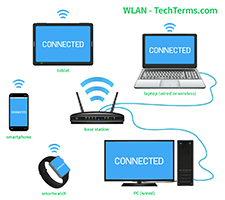WLAN
Stands for "Wireless Local Area Network." A WLAN, or wireless LAN, is a network that allows devices to connect and communicate wirelessly. Unlike a traditional wired LAN, in which devices communicate over Ethernet cables, devices on a WLAN communicate via Wi-Fi.
While a WLAN may look different than a traditional LAN, it functions the same way. New devices are typically added and configured using DHCP. They can communicate with other devices on the network the same way they would on a wired network. The primary difference is how the data is transmitted. In a LAN, data is transmitted over physical cables in a series of Ethernet packets. In a WLAN, packets are transmitted over the air.
As wireless devices have grown in popularity, so have WLANs. In fact, most routers sold are now wireless routers. A wireless router serves as a base station, providing wireless connections to any Wi-Fi-enabled devices within range of the router's wireless signal. This includes laptops, tablets, smartphones, and other wireless devices, such as smart appliances and smart home controllers. Wireless routers often connect to a cable modem or other Internet-connected device to provide Internet access to connected devices.
Advantages of WLANs
The most obvious advantage of a WLAN is that devices can connect wirelessly, eliminating the need for cables. This allows homes and businesses to create local networks without wiring the building with Ethernet. It also provides a way for small devices, such as smartphones and tablets, to connect to the network. WLANs are not limited by the number of physical ports on the router and therefore can support dozens or even hundreds of devices. The range of a WLAN can easily be extended by adding one or more repeaters. Finally, a WLAN can be easily upgraded by replacing routers with new versions — a much easier and cheaper solution than upgrading old Ethernet cables.
Disadvantages of WLANs
Wireless networks are naturally less secure than wired networks. Any wireless device can attempt to connect to a WLAN, so it is important to limit access to the network if security is a concern. This is typically done using wireless authentication such as WEP or WPA, which encrypts the communication. Additionally, wireless networks are more susceptible to interference from other signals or physical barriers, such as concrete walls. Since LANs offer the highest performance and security, they are still used for many corporate and government networks.
NOTE: WLAN should not be confused with "WAN," which is a wide area network.
 Test Your Knowledge
Test Your Knowledge